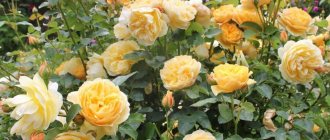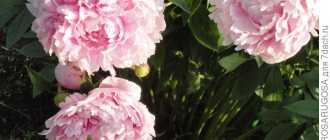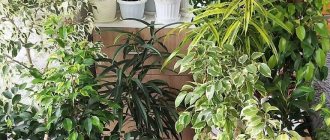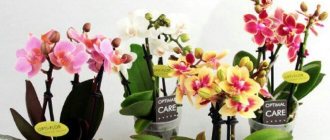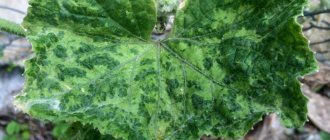Author: Elena N. https://floristics.info/ru/index.php?option=com_contact&view=contact&id=19 Category: Garden plants Published: January 20, 2019Republished: February 20, 2019Last edits: February 17, 2021
- How to plant
- Home freesia
- Armstrong's Freesia (Freesia armstrongii)
Freesia or Cape lily of the valley has not gone out of fashion for hundreds of years. Once upon a time it was hunted by court gardeners and perfumers, now by fashionable florists, brides and photographers. If you dream of growing this outrageous celebrity of the flower world yourself, be patient and arm yourself with the invaluable experience of your colleagues.
- How to grow freesia without a greenhouse?
- What color freesia grows the fastest?
- How to provide moist air to your home freesia and not destroy it?
- Is it possible to make capricious freesia bloom in the middle of winter?
Let's figure it out together!
Planting and caring for freesia
- Planting: in open ground from the second decade of May. For forcing by January - at the end of August in a pot.
- Excavation: October.
- Storage: a month after digging at a temperature of 25˚C, then before planting at 10˚C.
- Flowering: in the garden – August-September.
- Lighting: light partial shade.
- Soil: loose, well-drained, neutral or slightly acidic.
- Watering: during growth and flowering - abundant and regular, then watering is gradually reduced.
- Fertilizing: in the garden: for seedlings - with nitrogen fertilizers, then twice a month with phosphorus and potassium fertilizers.
- Reproduction: seed and vegetative (corms).
- Pests: thrips, spider mites, aphids.
- Diseases: fusarium, scab, gray, dry, penicillium, hard and sclerotial rot.
Read more about growing freesia below.
Freesia (lat. Freesia) , or freesia , is one of the most charming bulbous plants grown both in the garden and at home. Freesia is a genus of herbaceous bulbous perennials of the Iridaceae (Iridaceae) family, which includes about 20 species. The most famous is hybrid freesia, which appeared as a result of crossing several species about a century ago. The plants are native to South Africa, where they grow along wet banks and among bushes. They received their name in honor of Friedrich Friese, a German botanist and doctor.
Freesia is elegant, graceful and delicate, it exudes a pleasant aroma reminiscent of the smell of lily of the valley, and for this it is sometimes called “Cape lily of the valley”. Thanks to all these qualities, it is now at the peak of popularity among gardeners as a cut crop.
- Planting and caring for petunia in the garden
Diseases and pests
Freesia grown at home rarely gets sick. But if care is not organized correctly, it is affected by diseases and pests.
- Sometimes the plant suffers from fusarium; due to frequent watering, the corm can rot. The affected bulb is completely eliminated along with the soil. The pot is sterilized. If the corm is slightly affected, it is cleaned of rot and treated with a fungicide. It is necessary to treat other flowers growing in the same container with it.
- The appearance of hardening on the bulb indicates that the gladioli have been affected by dry rot. The plant cannot be protected. The onion is thrown away.
Freesia can be attacked by spider mites, aphids, and thrips. The flower is treated with phytoverm or other insecticides. Despite some of the vagaries of freesia, it is loved for its delicate appearance and delicate aroma. The plant, feeling cared for, presents bright flowers at the most solemn moment.
Features of the plant
Freesia flower:
- is a decoration for any bouquet, it is especially attractive for brides;
- does not fade for a long time, does not lose freshness;
- thanks to its aroma, it became interesting to manufacturers of luxury perfumes;
- takes its rightful place in landscape design;
- grown both in open ground (in greenhouses and gardens) and on window sills;
- red-yellow in color grows faster than other varieties.
In the photo: Growing white freesias in the garden
Hybrid freesia reaches a meter in height, has a bare, highly branched stem, and a corm covered with thin brownish scales. The leaves are thin, with a central vein, 15-20 cm long and 1-1.5 cm wide. Fragrant flowers 3-5 cm long are collected in weak one-sided inflorescences. The color of flowers can be any - white, red, orange, blue, purple, yellow, cream, pink... Often the throat of a flower has a contrasting shade in relation to the petals. The fruit of freesia is a capsule.
Origin
The flower was named in honor of the German scientist Frese, who first described the flower.
Freesia began its spread from South Africa, namely from the Cape region. There it grows in moist soils along river banks.
Some species of this genus grow in the African tropics. This name of the plant was received in honor of the German scientist Frese, who first described this flower. Freesia was first brought to Europe in the 18th century, but it began to be cultivated as an ornamental flower only a century later. People especially liked that each variety had its own flavor. It is known that at the end of the 19th century, freesia became widespread in Russia, where it was very highly valued.
Growing conditions
It is best to grow freesia in a greenhouse or greenhouse, where it is easier for it to create the necessary conditions, but this is an activity for experienced or professional gardeners. In principle, freesia can be grown all year round, but since garden freesia does not overwinter in the ground in our latitudes, its tubers will have to be removed from the ground in the fall. But this plant is also used as a potted plant, and indoor freesia blooms just in winter. There are general requirements for all types of freesia, which we will introduce you to.
- Freesia is a very light-loving ; it needs light for 12-14 hours every day, but direct sunlight is destructive, so the best place for freesia is light partial shade.
- Make sure there is protection from drafts .
- The soil is loose with good drainage. Optimal soil composition: peat, leaf, humus and turf soil in equal proportions. Low acidity is preferred.
- Broad-leaved and spreading varieties are planted more freely, while narrow-leaved and small-flowered varieties are planted more compactly.
- If you are interested in lush flowering, then you need a strict temperature regime: before flowering - no higher than 22ºС.
- Flowers can be cut only after at least two flowers in the inflorescence have fully opened. Wilted flowers must be removed so that they do not take away nutrients from newly formed ones.
- Some freesias (in particular, broken freesia varieties) have weak stems that need support , do not forget about this.
- Freesia loves moist air , but when spraying plants, try to do it so that the water does not get on the flowers and buds. The best time for this is 17-18 hours.
- Too hot or too cool weather contributes to deformation of flowers and the formation of empty buds.
In the photo: Growing freesia seedlings in a container
Growing freesia in open ground
How to grow
Before planting freesia in open ground, it is better to grow the freesia bulbs a little. In March-April, peel the corms from scales and, to prevent fungal diseases, keep them for half an hour in a 0.2% solution of foundationazole. Then place them in fertile, loose soil in peat pots to a depth of 5 cm and keep them on a well-lit windowsill or on a warm loggia until planting.
How to grow ranunculus - tips from experienced gardeners
Some experienced gardeners practice growing freesia from seeds , and although the process is tedious and unreliable, we will tell you how it is done. Moisten the prepared soil and carefully spread the seeds, cover with a two-centimeter layer of soil mixture for seeds, cover with film or glass and keep in a bright place. In twenty days the shoots will appear. When they grow to 2-3 cm, remove the glass and thin them out well. Plant in the ground in mid-May.
- How allamanda blooms
Freesia planting
Freesia is planted in open ground in the spring, after the last frost has passed (somewhere after May 9). We prepare the holes so that the planting depth is about 3-6 cm. Large tubers are planted at a distance of 5 cm, small ones at a distance of 3 cm. The distance between rows is 15 cm. Level the soil and mulch it with coniferous soil or peat to protect it, and at the same time the freesia roots, from overheating. By August, your freesias will produce 1-3 peduncles, and will bloom until the beginning of October.
In the photo: Planting freesias in the ground
Caring for freesia in the garden
During the period of freesia growth, fertilizing is necessary. The first feeding (after seedlings) is carried out with ammonium nitrate (20 g of nitrate per 10 liters of water), then twice a month with potassium salt and superphosphate (20 g and 40 g per 10 liters of water, respectively). In addition, freesia in the garden needs loosening the soil and weeding, especially in the first half of the growing season.
Growing freesia in the garden requires a certain regime of watering the plant. During growth and flowering, freesia should be watered abundantly and regularly, the soil should be constantly moist. Freesias bloom for three to six weeks, then watering is gradually reduced until it stops completely.
It is also advisable to increase air humidity by spraying the stems and leaves of freesia. Both are best done in the evening, but so that the moisture has time to be absorbed. In open ground, freesia is kept until frost.
Advice from professionals on growing eustoma at home and in the garden
Diseases and pests
Freesia has the same difficulties as gladioli: thrips, aphids, spider mites, as well as scab, fusarium and all kinds of rot. Affected plants must be removed and destroyed, and to avoid all these troubles, you just need to disinfect the bulbs before storage with a light solution of potassium permanganate and repeat this procedure before planting. During the process of growth and flowering, observe the regime and degree of watering: do not over-moisten the soil, but do not let it dry out.
Freesias at home
How to plant
Growing freesia at home is carried out mainly for the sake of its winter-spring flowering. Imagine: it’s winter outside, there’s snow in the garden, and there’s a garden on your windowsill. In order to get flowering freesia in January, freesia bulbs need to be planted in the ground before the beginning of September, after soaking them for half an hour in a solution of azotobacterin at the rate of 0.5 g per 10 liters of water.
You can treat the corms with growth stimulants - Epin or Kornevin.
- Sprekelia
At the bottom of a pot with a diameter of 15 cm, you need to lay a drainage mixture and charcoal, then pour in suitable soil (sand, turf and humus soil 1:2:1) with a small amount of potassium-phosphorus fertilizers and place 5-6 bulbs in it to a depth of 5- 6 cm. The pot with freesia is placed in a cool (10-15 ºC) bright room and kept without watering, but as soon as the leaves appear, the plant is transferred to a warm place (20-22 ºC) and watering begins.
In the photo: Planting freesia in pots on the windowsill
How to care
Planting and caring for freesia at home is much easier than caring for it in the garden or greenhouse, but there are nuances that are important to know. In the autumn-winter period, daylight hours are shorter than in summer, and freesia needs lighting at least 12 hours a day. Therefore, you will have to create additional lighting for the freesia with fluorescent lamps if you do not have the opportunity to keep the freesia on eastern or western windowsills. In addition, do not forget to put supports, since weak freesia stems may not withstand the weight of the flowers and will break.
Watering is carried out with settled water after the top layer of soil dries. During the flowering period, watering should be not only regular, but also abundant. During the heating season, it is extremely important that the air around freesias is not too dry, so be sure to spray the plants. Or keep them in a cooler place, such as a glassed-in loggia. Well, feed the freesia once every two weeks with mineral fertilizers until the leaves wither.
In the photo: Growing freesias in an apartment
Reproduction methods
Seeds
The seeds are poured with water at room temperature for a day, then mixed with moistened sand, spread in a thin layer and kept for 14 days. Then the hatched seeds are sown to a depth of 1 cm. The air temperature in the room should be in the range of +20...+22 degrees, humidity about 70%. This can be ensured by covering the box with glass or plastic film.
Plants are moistened and ventilated daily.
After the sprouts appear (after 20-30 days), the container is transferred to a well-lit place. Plants must receive lighting for at least 12 hours a day; you can use a phytolamp for growing. The air temperature must be reduced to +12…+14 degrees. In the future, to stimulate branching of shoots and active flowering, the temperature is reduced to +8...+10 degrees. When the height of the plant reaches 10 cm, it needs to be tied up. 9 months after sowing, flowering begins.
Corms
Before planting, planting material should be stored at a temperature of +20...+30 degrees and high humidity. This method of reproduction includes the following steps:
- planting – formation of inflorescence primordia. Lasts 1.5 months. Corms are planted when the air temperature is in the range of +18…+22 degrees. They germinate in 2-3 weeks;
- a new renewal bud is formed at the base of the peduncle. The temperature is reduced to +10...+15 degrees. When the budding phase begins, the temperature is increased to +15...+17 degrees;
- Children and replacement corms are actively growing and developing. The air temperature should be +15...+25 degrees, watering the plants is reduced, and watering is stopped 14 days before digging them out.
Freesias after flowering
Home freesia
As soon as your freesia has faded, the leaves and stem are cut off, and the bulb continues to be watered for another month and a half so that new bulbs form on it. Then the corm is removed from the ground, disinfected with a solution of potassium permanganate, dried for several days in a warm place and sent for storage.
How to plant and care for Ixia correctly
Garden freesia
At the end of September or beginning of October, when the freesia has faded and the leaves have turned yellow, but have not yet dried out, the corms are removed from the ground, the stem with leaves is cut off, the bulbs are cleaned of soil, roots and old scales, and kept for 30 minutes in a weak disinfectant solution of sodium permanganate or any fungicide (Maxim, Fitosporin, Fundazol) and dried for several days at a temperature of 25-28 ºC in a ventilated area. Then the bulbs are sorted, removing damaged or rotten ones, and sent for storage.
In the photo: Germinating freesia bulbs at home
Bulb storage
Freesia bulbs are stored in nets at a temperature of 20-25 ºC in a room with high air humidity (70-80%). If there is no such room, then place a container of water under the net with the bulbs. Planting material must be reviewed at least once a month, separating rotten or diseased corms. A month before planting, the bulbs should be placed in a cooler place (10-15 ºC).
In the photo: Freesia bulbs before storage
Some gardeners recommend storing freesia corms in dry peat. And if there are no cold and frosty winters in your latitudes, you can leave the bulbs in the ground, covering them with fallen leaves or spruce branches.
Types and varieties
Most often in floriculture, hybrid freesia (Freesia hybrida) is used, obtained by crossing species such as refracted freesia (Freesia refracta) and Armstrong freesia (Freesia armstrongii). These same types of freesia gave rise to many varieties that we will tell you about.
Armstrong's Freesia (Freesia armstrongii)
A plant reaching a height of 65-70 cm. Flowers (scarlet, pink or red) are bell-shaped, fragrant, collected in panicles of 3-5 pieces. The tube is white with yellow spots. The leaves are xiphoid, long. Varieties of this freesia bloom from May to June.
One of the most beautiful varieties of Armstrong freesia is Cardinal . This is red freesia, non-double, tall (70 cm). One bulb produces three peduncles 35 cm long, the number of flowers in a panicle is from 9 to 11, the length of the inflorescence is 9 cm. The flowers are dark red with a yellow spot, the stamens are yellow, the pistil is blue, the anthers are purple.
In the photo: Growing yellow freesias at home
Hybrid freesia (Freesia hybrida)
Combines the best qualities of its ancestors. Its bush is tall (up to 1 m) and highly branched, the brushes consist of large (5-7 cm in diameter) fragrant flowers of purple, crimson, yellow and other shades, both single-color and two-color.
- Ballerina variety - white freesia with yellowness at the base, corrugated petals. The throat is also white, with a yellow stripe. The inflorescence contains up to 12 flowers measuring 5.5x6.5 cm. Peduncles are 25-30 cm high. It has a delicate aroma;
- variety Rose Marie - peduncles 20-25 cm high, in an inflorescence up to 7 flowers 4.5x4.5 cm of bright crimson color, in the lower part of the flower - white with a crimson line;
- variety Pimperina - low peduncles (15-20 cm), in the inflorescence there are up to 7 flowers 6x5.5 cm, petals are slightly corrugated, red with dark red edges. The bottom of the petals is yellow with red strokes. The aroma is inexpressive.
In the photo: Hybrid white freesia
White freesia, or refracted, or broken (Freesia refracta)
This species is distinguished by its miniature forms (no higher than 40 cm). The stems are thin, spreading, the inflorescence is a paniculate spike, in which there are 2-5 flowers of white or yellow-orange color. Blooms in April.
- Alba freesia (Freesia refracta var. alba) – large snow-white flowers with purple strokes on a yellow background inside the throat;
- fragrant freesia (Freesia refracta odorata) – yellow freesia, in the inflorescence there are 3-7 flowers with an orange spot at the base. It smells like lily of the valley.
In the photo: How freesia blooms in open ground
All three cultivated species are represented by both simple-shaped and terry varieties. Simple freesia has one row of petals, double freesia has two or more. In a flower shop you can buy not only a specific variety of freesia, but also a mixture of varieties in a set - freesia mix will give you the opportunity to grow a whole scattering of beautiful freesias of different shapes and shades on your plot.
Botanical description
Freesia (Cape lily of the valley) is a fragrant, herbaceous, beautifully flowering perennial. The plant belongs to the iris family. Brought to Europe from the unique ecosystem of the former Cape Province in South Africa. The aroma of the flower is really similar to the aroma of lily of the valley, moreover, freesia lasts for a long time, more than a week, when cut.
The flower shows amazing diversity in sizes: from miniature (25 cm) to spectacular, a meter tall. Freesia leaves are long (up to 20 cm), narrow, with a wide vein in the center.
On one peduncle growing from a corm, there are up to 5 flowers; the inflorescence is loose, one-sided. The flowers are tubular, 3-5 cm in length, shaped like a funnel, expanding from a narrow base to 6 cm in diameter.
